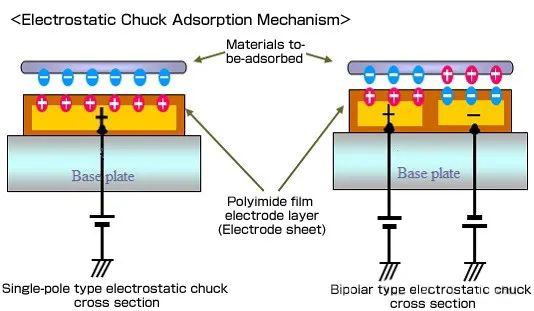
- English
- Español
- Português
- русский
- Français
- 日本語
- Deutsch
- tiếng Việt
- Italiano
- Nederlands
- ภาษาไทย
- Polski
- 한국어
- Svenska
- magyar
- Malay
- বাংলা ভাষার
- Dansk
- Suomi
- हिन्दी
- Pilipino
- Türkçe
- Gaeilge
- العربية
- Indonesia
- Norsk
- تمل
- český
- ελληνικά
- український
- Javanese
- فارسی
- தமிழ்
- తెలుగు
- नेपाली
- Burmese
- български
- ລາວ
- Latine
- Қазақша
- Euskal
- Azərbaycan
- Slovenský jazyk
- Македонски
- Lietuvos
- Eesti Keel
- Română
- Slovenski
- मराठी
- Srpski језик
What is Electrostatic Chuck(ESC)?
2024-08-30
In semiconductor manufacturing, the precision and stability of the etching process are paramount. One critical factor in achieving high-quality etching is ensuring that wafers are perfectly flat on the tray during the process. Any deviation can lead to uneven ion bombardment, causing undesirable angles and variations in etching rates. To address these challenges, engineers have developed Electrostatic Chucks (ESCs), which have significantly improved etching quality and stability. This article delves into the design and functionality of ESCs, focusing on one key aspect: the electrostatic principles behind wafer adhesion.
Electrostatic Wafer Adhesion
The principle behind the ESC's ability to securely hold a wafer lies in its electrostatic design. There are two primary electrode configurations used in ESCs: single-electrode and dual-electrode designs.
Single-Electrode Design: In this design, the entire electrode is spread uniformly across the ESC surface. While effective, it provides a moderate level of adhesion force and field uniformity.
Dual-Electrode Design: The dual-electrode design, however, uses both positive and negative voltages to create a stronger and more uniform electrostatic field. This design offers higher adhesion force and ensures that the wafer is held tightly and evenly across the ESC surface.
When a DC voltage is applied to the electrodes, an electrostatic field is generated between the electrodes and the wafer. This field extends through the insulating layer and interacts with the wafer's backside. The electric field causes the charges on the wafer surface to redistribute or polarize. For doped silicon wafers, free charges move under the influence of the electric field—positive charges move towards the negative electrode, and negative charges move towards the positive electrode. In the case of undoped or insulating wafers, the electric field causes a slight displacement of internal charges, creating dipoles. The resulting electrostatic force firmly adheres the wafer to the chuck. The strength of this force can be approximated using Coulomb's law and the electric field strength.





